British labor movement to 1868
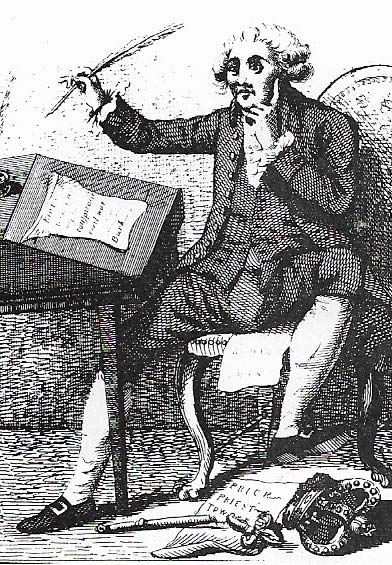
Figure 1. Thomas Payne's (1737–1809) The Rights of Man (1791–1792) was published in reply to Edmund Burke's (1729–1797) criticisms of the French Revolution. It did much to stimulate popular radicalism. However, threat of prosecution forced Paine to flee the country for France in September 1792.
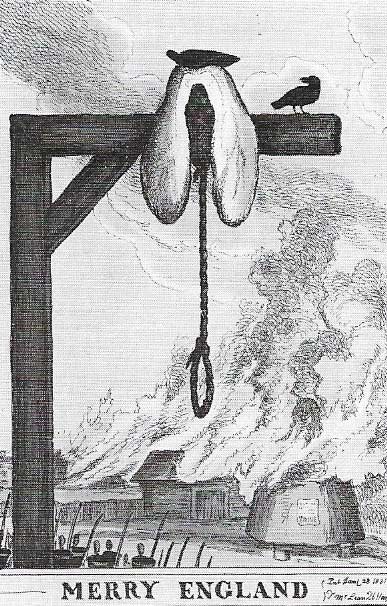
Figure 2. Disturbances broke out in England between 1830 and 1832 in which agricultural laborers protested against unemployment, low wages and the introduction of threshing machines. The unrest was not politically motivated, but a reaction to growing poverty. Nine laborers were hanged and 457 transported.
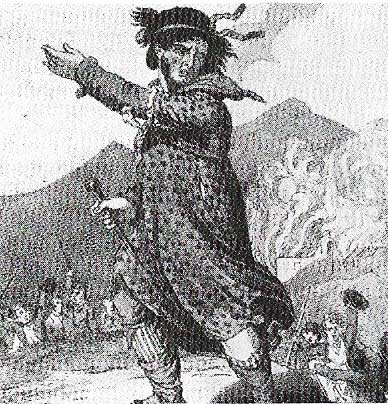
Figure 3. Luddite rioters of 1810–1812 and 1816–1817 smashed factory machinery in protest against the introduction of new equipment in the hosiery and woollen cloth industries. The protesters claimed to be led by a "Ned" of "King Ludd" whose name was attached to public letters denouncing the introduction of the new machinery. The riots caused a series of harsh measures to be enacted by the government.
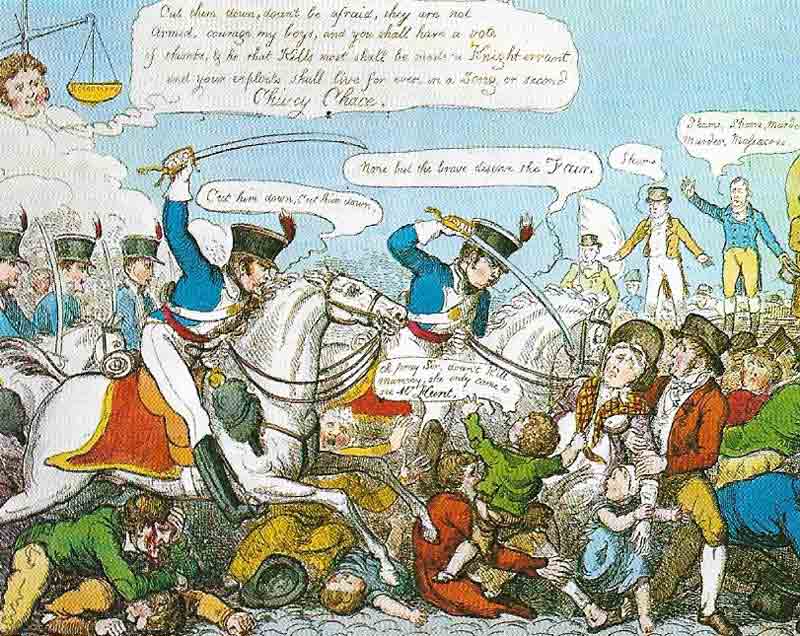
Figure 4. The Peterloo Massacre, so-called, was a tragic fracas that took place in August 1819. Manchester reformers called a meeting at which the radical demagogue "Orator" Henry Hunt (1773–1835) was to speak. But the local magistrates, fearing trouble, ordered the Yeomanry to arrest Hunt at the meeting. When this failed, Hussars were sent in against 60,000, and in the ensuing confusion 11 people were killed and more than 400 injured, including women and children. The incident was used by the government as a pretext for introducing a fresh wave of repressive legislation, the Six Acts, against "seditious assemblies" and politically "subversive" literature.
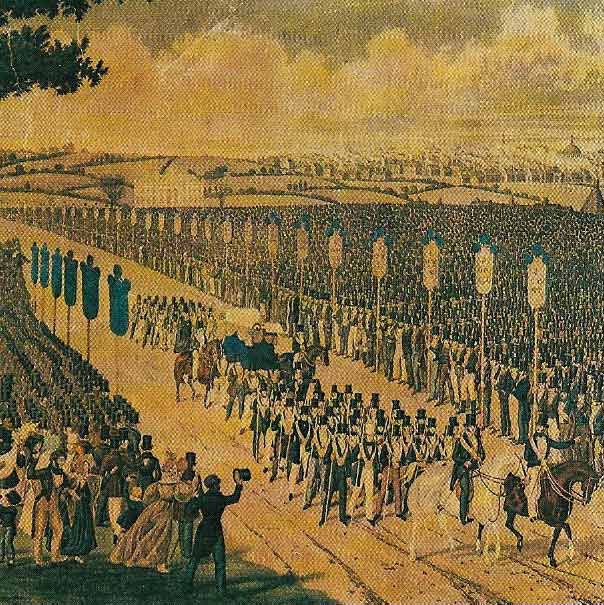
Figure 5. The precarious legal status of early trade unions was illustrated when six Dorset laborers were arrested in 1834 for swearing men into a union at the village of Tolpuddle. All were sentenced to seven years transportation. After demonstrations such as this, they were pardoned in 1836.
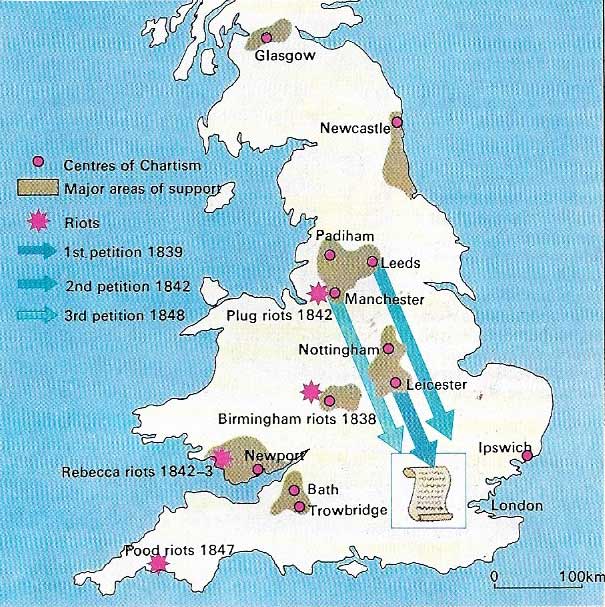
Figure 6. Chartism, expressed in the People's Charter, owed its origins to the failure of the 1832 bill fully to enfranchise the working man. The Charter demanded male suffrage, secret ballot, annual parliaments, equal electoral districts, an end to property qualifications for MPs and the introduction of official payment for them.
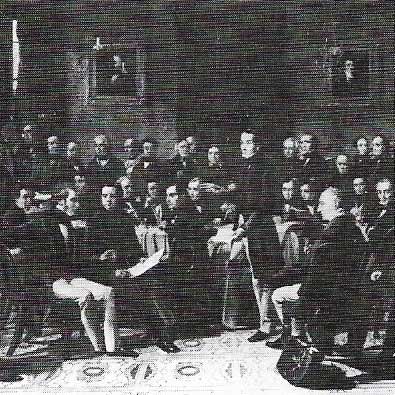
Figure 7. The Anti-Corn Law League, which was mainly composed of industrialists, was founded in 1839 to oppose the duties on imported corn that protected domestic producers. Although the League was campaigning for cheaper food in opposition to the power of the landed classes, the Chartists and the working classes did not fully support it. The Chartists argued that in reality the League wanted wages reduced by the amount that corn prices would fall if the Laws were repealed.
Craft organizations had existed for centuries in Britain, usually protected by a framework of paternalistic legislation that determined terms of apprenticeship and wages. With the growth of towns and industry during the Industrial Revolution in the eighteenth century, the old craft regulations came under pressure from employers who sought to free industry from rigid restrictions and to introduce labor-saving machinery.
Unrest and the Combination Laws
The war with revolutionary France, which opened in 1793, were marked by high prices and labour unrest. Fearing the growth of radical ideas among the lower classes, the government passed the Combination Laws of 1799–1800. These were the culmination of a series of laws against "combinations" is specific trades. The Combination Laws prohibited any association between two or more workmen to gain either an increase in wages or a decrease in hours. Unions were forced to operate in secret or under guise of "non-political" Friendly Societies, which were recognized as legal in 1793.
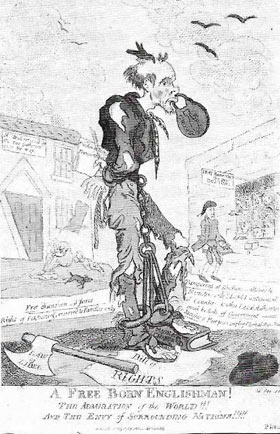 |
| Repressive measures were adopted by the government against radical societies which arose following the French Revolution. Habeas corpus was suspended in May 1794, and some radical leaders were charged with high treason. In 1795, following an attack upon the King's coach in October, the Two Acts were passed. These restricted the right of free assembly and extended the law of treason to cover acts of speech and writing. The laws against combinations restricted the growth of trade unions. After 1815 the government again resorted to laws against meetings and radical propaganda, in the "gagging" Acts of 1817 and the Six Acts of 1819. |
The economic warfare between Britain and France in the latter part of the Napoleonic Wars brought trade depression and hardship to the growing industrial areas. In 1810–1812 there occurred the most serious wave of Luddite disturbances (Figure 3), in which workmen under a mythical leader, "King Luddite", destroyed machinery which they saw as threatening their livelihood.
This violence was in large part the traditional reaction of workmen threatened with a decline in their working standards. The degree of union organization in the Luddite outbreaks is obscure, but some elements of union organization were undoubtedly present in Nottinghamshire. Further outbreaks of machine-breaking in 1816–1817 and 1826 were also firmly repressed.
In the post-war years, continued distress and radical agitation for parliamentary reform made government suspicious of trade union activities. Strikes in the factory districts took place in spite of the Combination Laws, most notably in Lancashire where the cotton spinners and weavers conducted an extensive strike in 1818. Elsewhere brick-makers and carpenters secured wage advances without being prosecuted.
Postwar agitation came to a climax in the St Peter's Fields meeting in Manchester of August 1819 (Figure 4). The Peterloo Massacre, as it was dubbed by the radical press, helped to create a more sympathetic attitude towards working-class organizations. The writings of men such as William Cobbett (1763–1835) were also creating a more self-conscious desire for improvement among workmen.
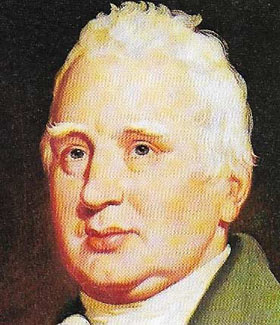 |
| William Cobbett was the most influential of the radical critics and writers in the parliamentary reform movement. Of humble origin, he published a number of radical newspapers including, in 1816, the weekly Political Register, which soon had an estimated sale of 60,000 copies a week among working men. His hatred of the new industrialism is evident in his documentary Rural Rides (1830). |
Growth in union membership
In the easier economic climate after 1820, the Combination Laws were attacked. A former tailor, Francis Place (1771–1854), devoted himself to the legalization of trade unions and, with the support of radical MPs, secured the repeal of the Combination Laws in 1824. Unions could now bargain about conditions although still surrounded by some restrictions. Attempts, in 1830 and 1833 to form a single national union failed. Many unions turned to "new model unionism", empathizing their respectability and rejecting militant activity.
By the 1840s most unions consisted of skilled workmen and the bulk of semi- and unskilled workers still lay outside union organization. The conviction of the "Tolpuddle Martyrs" in Dorset in 1834 (Figure 5) for administering unlawful oaths showed the obstacles that could still face unskilled workers who tried to organise themselves.
Many unions took an ambivalent attitude towards the Chartist demands for the vote contained in the People's Charter (Figure 6). Elite craft groups, such as the engineers or potters, were reluctant to align themselves with a movement tainted with violence and disorder. Some of the declining crafts, however, such as the handloom weavers, participated in Chartism as a desperate attempt to reverse their deteriorating situation.
With the decline of Chartism after 1848, the craft unions continued to consolidate their position. By 1852, the Amalgamated Society of Engineers had 12,000 members, centralised control, and high rates of subscription, which enabled it to wage successful strikes. Unskilled workers formed organizations, such as the Miners' Association of 1842, but still lacked the solidarity and strength of the skilled workmen.
From the period of model unionism, there was an improvement in the public image of the trade union movement. The Friendly Societies and Co-operative Movement, founded at Rochdale in 1844, were aided by middle-class sympathizers.
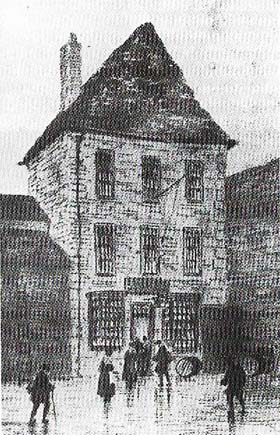 |
| The first Co-operative shop, a non-profit making retail store, was one of a number of co-operative ventures in the 1830s and 1840s. By selling cheap and pure food it was the most successful. |
Coordination of union activities
In 1866–1867, a short trade slump in the midst of improving conditions led to a number of strikes and some violence, notably at Sheffield. The "Sheffield Outrages" led to a Royal Commission recommended putting trade unions upon a firm legal basis and allowing them to secure their funds. These gains were established in the Trade Union Act of 1871. In 1868 the Trade Union Congress (TUC) was founded in Manchester with 34 delegates. In 1869 in Birmingham, quarter of a million trade unionists were represented at the TUC by 40 delegates and a "Parliamentary Committee" was established to represent trade union interests.
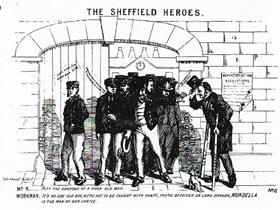 |
| The "Sheffield Outrages", a series of violent incidents directed at non-union members, led to the establishment of a Royal Commission to investigate the status of trade unions. In 1867 union status was further put into question by a ruling that they were defenceless against officials who absconded with union funds. Unions were represented on the Commission which recommended that they be given a legal basis. |
